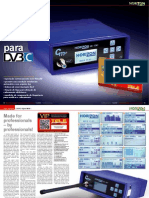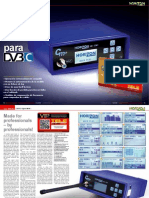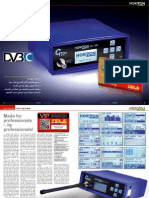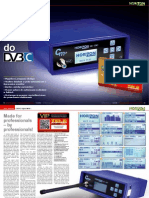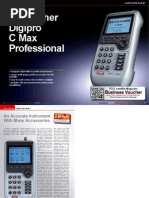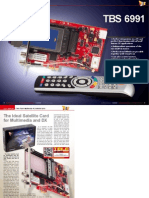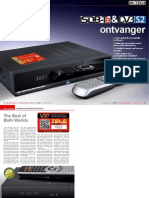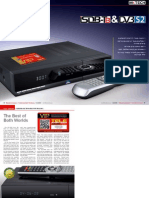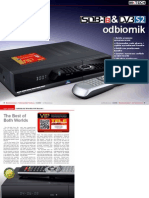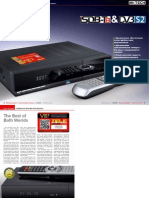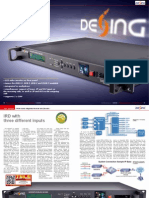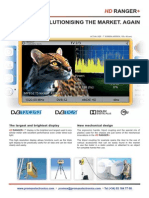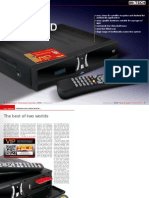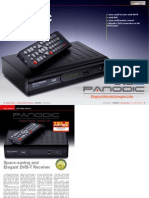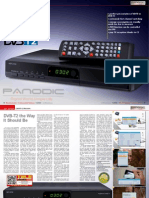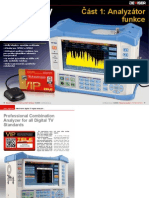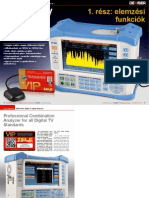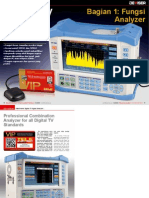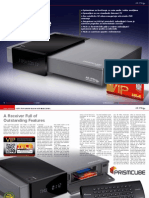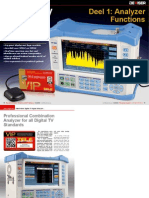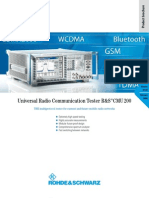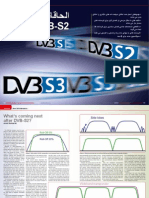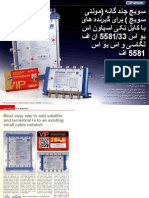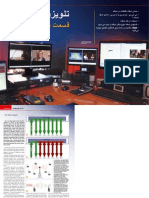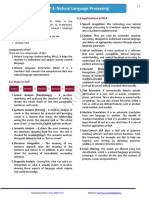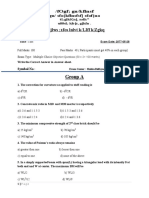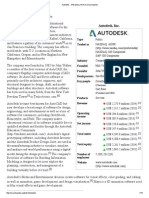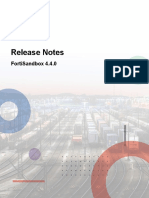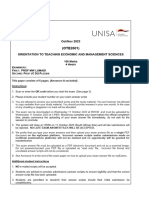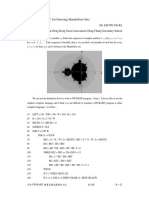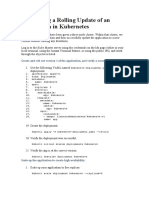TELE-audiovision International - The World‘s Largest Digital TV Trade Magazine TELE-audiovision International - 全球发行量最大的数字电视杂志
TELE-audiovision International - The World‘s Largest Digital TV Trade Magazine TELE-audiovision International - 全球发行量最大的数字电视杂志
Uploaded by
Alexander WieseCopyright:
Available Formats
TELE-audiovision International - The World‘s Largest Digital TV Trade Magazine TELE-audiovision International - 全球发行量最大的数字电视杂志
TELE-audiovision International - The World‘s Largest Digital TV Trade Magazine TELE-audiovision International - 全球发行量最大的数字电视杂志
Uploaded by
Alexander WieseOriginal Title
Copyright
Available Formats
Share this document
Did you find this document useful?
Is this content inappropriate?
Copyright:
Available Formats
TELE-audiovision International - The World‘s Largest Digital TV Trade Magazine TELE-audiovision International - 全球发行量最大的数字电视杂志
TELE-audiovision International - The World‘s Largest Digital TV Trade Magazine TELE-audiovision International - 全球发行量最大的数字电视杂志
Uploaded by
Alexander WieseCopyright:
Available Formats
- +
62 TELE-audiovision International The Worlds Largest Digital TV Trade Magazine 09-10/2013 www.TELE-audiovision.com
www.TELE-audiovision.com 09-10/2013 TELE-audiovision International
63
TEST REPORT
DVB-C Signal Meter
1 6 11
Made for professionals by professionals!
A reliable signal meter is one of the most important tools for professional installers of new DVB-C networks for hotels, apartment buildings and small residential estates or for distributing existing DVB-C signals. Horizon has come up with just the right device for all those demanding installers out there: The HD-CM+ for DVB-C signals, launched by a long-time manufacturer of top-notch signal meters which TELEaudiovision readers have come to know and appreciate through numerous test reports. The blue signal meter measures 17 x 16 x 6.5 cm, weighs approximately 1 kg and sports the tried-andtested Horizon design that has proven its worth in many previous tests. On the front users of the new HD-CM+ can find a female socket for the signal input. High up on the wish list of most installers is an option to exchange that socket, and Horizon has gladly met that demand. In case youre wondering why this is an issue at all the signal input socket is usually the first component of a meter to fail due to all those different cables that need to be connected and disconnected again during active use. Right next to the socket there is a perfectly readable LCD display, as well as a total of five buttons for using all functions of the meter. Turning the meter around will give you access to the power socket on the back, as well as a USB interface and connection for the external 12V car charger on the side. The built-in Ni-MH battery pack is located on the bottom side and is protected by a sturdy flap. We love the fact that the battery pack can be accessed without the need for additional tools and therefore can easily be exchanged, if need be. After all, nothing is more annoying than running out of power during a major installation job. Horizon has also been generous as far as included accessories are concerned. The HD-CM+ comes with all required cables (power supply, USB), a car charger, a very handy display cover for rainy days, an external antenna for detecting faulty cables or interfering signals, and a heavy-duty carrying bag made of nylon. This way, the meter is always at hand while at the same time being protected from the elements or damage. The manual that is also part of the package is clearly structured and deals with all functions of the signal meter in a straightforward way. Horizon recommends charging the battery pack of the HD-CM+ for eight hours before using the meter for the first time. This makes sure the battery reaches its maximum capacity and provides optimum performance. It goes without saying that we heeded that advice and connected the meter to the mains overnight. Speaking of which, the internal power pack can handle any voltage between 90V and 250V AC, which makes it a true globetrotter. During the charging process an indicator on the display shows the
09-10/2013
Horizon HD-CM+ fr DVB-C Extremely easy to operate, for professional installers
12
www.TELE-audiovision.com/13/09/horizon
current battery status at any time, which is a nice feature as it gives you some hint as to when the charging cycle will be completed. And while were at it, lets have a closer look at the monochrome LCD display at this stage. Offering a resolution of 128 x 64 pixels it sports remarkable readability in dark surroundings thanks to its backlight feature, but also in direct sunlight thanks to its excellent contrast settings. As far as the battery pack is concerned, Horizon has opted for a 3300 mAh Ni-Mh battery which allows seven hours of continuous operation without external power supply. This in turn means that a single cycle will get most professional installers through a regular workday. Similar to other Horizon meters the HD-CM+ is brought to life with a feisty touch of the arrow down button. Installers can then call up the settings menu right away in order to customise the meter according to their requirements. This is where you can adjust the backlight mode, display brightness and display contrast, or you can activate automatic shutdown
1. Horizon HD-CM+ Logo 2. The three scan modes of the HD-CM+ 3. Signal level measurement 4. MER measurement 5. BER measurement 6. Manual scan with spectrum display 7. Selecting one of five pre-set channel allocation plans 8. Comparison measurement of five different frequencies 9. Comparison measurement of five different frequencies with signal level difference shown 10. Spectrum display 11.Settings menu 12. Settings menu 13. Leakage test 14. Constellation diagram 15. Individual channels can easily be selected for a comparison measurement
13
14
10
15
after a pre-set period of inactivity. This is a particularly useful feature, as it avoids drawing all power out of the battery pack simply because you forgot to switch off the meter. Measurement results can be given in dBV, dBmV or dBm and an automatic noise limiter can be set between -75 dBm and -55 dBm. Lastly, default factory settings can also be restored through the settings menu. Right after turning on the
64 TELE-audiovision International The Worlds Largest Digital TV Trade Magazine 09-10/2013 www.TELE-audiovision.com
www.TELE-audiovision.com 09-10/2013 TELE-audiovision International
65
HD-CM+ installers will be happy to find themselves smack in the scan menu which lets them select one of three available scan modes: full scan, short scan and manual scan. Before we explain all three varieties and make a selection for testing purposes, we should mention that the HD-CM+ signal meter is capable of storing up to 20 pre-defined channel allocation plans in its internal memory. Those plans are
available for dozens of DVBC providers worldwide and allow fast access to all active frequencies of a given cable network. In case no channel allocation plan is available for the provider at hand you can always fall back on a standard channel plan that includes all UHF and VHF frequencies. Channel allocation plans can easily be selected for download from the manufacturers website at www.horizonhge.
com. All data will be packaged into a ZIP file that can be downloaded to a PC. All that is left to do then is to use the USB cable for connecting the meter to the PC. All drivers that are required to that end are also available from the Horizon website. File transfer worked flawlessly during our test and without any additional user input, since the zipped channel allocation plans come complete with all necessary
software. Only pre-defined plans can be downloaded without an option for creating a customised plan; however, customised plans can be requested from Horizon directly. Our test PC runs with Windows 8, so were happy to confirm that both drivers and software work smoothly with the latest Microsoft operating system. As the name implies, a full scan goes through the currently selected channel plan in its entirety, from A to Z, or from Z to A by pushing the LEFT/RIGHT buttons. With a short scan it is possible to look at specifically selected frequencies of the current channel plan, and a manual scan allows users to chose a single frequency from a frequency selection with spectrum view. Both in full scan mode and short scan mode the HD-CM+ starts from the lowest frequency and works itself up to the highest frequency of the plan. Whenever an active frequency is
66 TELE-audiovision International The Worlds Largest Digital TV Trade Magazine 09-10/2013 www.TELE-audiovision.com
found, the scan stops and a measurement is initiated. In addition, the meter gives out the following parameters for each active frequency, depending on the actual signal type: RF, signal level, MER and BER for digital signals, and RF video signal level, RF audio signal level as well as SNR for analog channels. Whats more, you dont only get a precise figure, but also an info bar! During our test the display did not only impress us with its clearly structured display layout, but also with absolutely flawless readability under all circumstances. So its easy to see why we could hardly wait to have a close look at the signal of our local DVB-C provider. As it turns out, no pre-defined channel allocation plan is available
Signal Level Horizon 328 MHz 394 MHz 562 MHz 59.6 dBV 64.7 dBV 59.7 dBV
MER Horizon 32.1 dB 34.7 dB 36.6 dB
BER Horizon 2.05E-4 2.69E-4 3.20E-7
Signal Level Reference 61.2 dBV 62.1 dBV 58.4 dBV
MER Reference 31.3 dB 33.5 dB 34.8 dB
BER Reference 2.3E-4 2.3E-4 3.1E-6
on the Horizon website for UPC Austria, our cable operator. Not to worry, though, as we simply used the standard channel plan that will do fine for situations like this. It didnt take long until the first measurement results popped up on our meters display, and we were amazed by the ease of use and smart simplicity of the HD-CM+. As always with signal meters that we test, we need to find out if the indicated values can be categorised as rough estimates (read: unreliable) or correct results
(read: good for professionals). To find out, we connected a second meter from another manufacturer and discovered that both devices showed almost identical results. The conclusion that can be drawn is that Horizon has made a point of equipping its latest professional meter with an excellent tuner. Have a look at table 1 to see for yourself which results
17
16. Pre-set channel allocation plans are available for convenient download from the manufacturers website (www. horizonhge.com) 17. Transfer tool of stored measurement results of the HD-CM+
16
68 TELE-audiovision International The Worlds Largest Digital TV Trade Magazine 09-10/2013 www.TELE-audiovision.com
we obtained for individual frequencies. Every time the Horizon signal meter detects an active frequency a touch of the OK button will call up a constellation diagram (for digital signals), plus all measured signal parameters can be saved onto the meters internal memory.For DVB-C, in particular, varying signal levels and somewhat inclined signal levels spread over the entire frequency band can create major problems. These issues are mostly caused by bad cabling, lowbudget splitters or signal feed units that are not properly configured. In order to address those issues, up to five active frequencies can be determined for a comparison measurement, with their signal levels shown side-by-side in a clearly presented overview. This way it is childs play to make all required signals adjustments. Another benefit: If you mark one of the five selected frequencies the meter calculates and shows the signal level difference between the marked and the other four frequencies. We also appreciated the spectrum view that is always very helpful for professional installers. The spectrums bandwidth can be adjusted right on the meter using the control buttons, with the following pre-defined options available: 8, 16, 32, 64, 128,256, 512 and 840 MHz. Each frequency can conveniently be selected using the left/right buttons and is shown in the upper section of the display, alternating with the current bandwidth and the measured RF signal level. If you then need to analyse the current frequency and find out all additional parameters, all you need to do is press the OK button. The range of options and functions of the HD-CM+ is completed with a so-called leakage test that allows quick identification of unintended signal loss or sources of in-
terference. In order to perform this test, installers have to attach the antenna that is shipped with the meter to the signal input of the HD-CM+ and then select one of the pre-set test frequencies. The meter then initiates a particularly intense noise level measurement whose results are shown on the display either as a grey bar (indicating that the measurement result is below the threshold and consequently no faults occurred) or as pronounced signal level peaks (indicating a problem somewhere along the line). Obviously, we gave this feature a thorough test as well and can report that it works brilliantly. Amateur users are usually happy with an easy-tooperate signal meter that gives them quick results. Professional installers, on the other hand, take money for their work and therefore frequently require written documentation for completed jobs. Once again, the HDCM+ delivers with its internal log function that can be used to store all measured signal parameters in the meters internal memory. Free software from the manufacturers website then allows using those data in the CSV format in MS Excel, for example. Our test showed that all values of the comparison measurement could easily by saved and imported into an XLS chart. Last but by no means least we should like to mention the built in voltmeter with a measurement range from 0 to 110 V. In summary, the Horizon HD-CM+ turned out to be an excellent DVB-C signal meter during our test. To a large extent, this is due its excellent usability and smart user interface. Added to that is a display with wonderful readability something that always sets an installers heart on fire. The comparison with a reference meter demonstrated that the measurement results turned out to be absolutely accurate.
expert
OPINION
Horizon HD-CM+ DVB-C Meter RECOMMENDED PRODUCT BY
Thomas Haring Test Center Austria
+ Easy to use and clearly structured, a perfectly readable display,
a wide range of functions and accurate measurement results all this makes the HD-CM+ a top-notch signal meter. Thanks to its capable battery pack, several included accessories and robust build quality it is just the right companion for professional jobs.
None
More about this company
www.TELE-audiovision.com/13/01/horizon.pdf
70 TELE-audiovision International The Worlds Largest Digital TV Trade Magazine 09-10/2013 www.TELE-audiovision.com
You might also like
- 7143cem Portfolio March2023 BriefDocument9 pages7143cem Portfolio March2023 BriefShubham BoradeNo ratings yet
- Digitalisation in Hospitality IndustryDocument10 pagesDigitalisation in Hospitality IndustryAbdullah KashifNo ratings yet
- Datum CLS360Document2 pagesDatum CLS360ArunNo ratings yet
- Horizon HD-CM+ For: Misuratore Di Segnale DVB-C Rapporto Di TestDocument5 pagesHorizon HD-CM+ For: Misuratore Di Segnale DVB-C Rapporto Di TestAlexander WieseNo ratings yet
- Horizon HD-CM+ Para: Medidor de Sinais DVB-C Relatório de EnsaioDocument5 pagesHorizon HD-CM+ Para: Medidor de Sinais DVB-C Relatório de EnsaiotelesatelliteporNo ratings yet
- Horizon HD-CM+ Para: Medidor de Señal DVB-C Informe de PruebaDocument5 pagesHorizon HD-CM+ Para: Medidor de Señal DVB-C Informe de PruebaAlexander WieseNo ratings yet
- Horizon HD-CM+ for: Уред за измерване на DVB-C сигнали Отчет за изпитванеDocument5 pagesHorizon HD-CM+ for: Уред за измерване на DVB-C сигнали Отчет за изпитванеAlexander WieseNo ratings yet
- Horizon HD-CM+ Pour: Mesureur de Signal DVB-C Rapport de TestDocument5 pagesHorizon HD-CM+ Pour: Mesureur de Signal DVB-C Rapport de TesttelesatellitefrenchNo ratings yet
- Horizon HD-CM+ Untuk: Meter Sinyal DVB-C Laporan UjiDocument5 pagesHorizon HD-CM+ Untuk: Meter Sinyal DVB-C Laporan UjiAlexander WieseNo ratings yet
- Horizon HD-CM+ For: DVB-C Mjerač Signala Test UređajaDocument5 pagesHorizon HD-CM+ For: DVB-C Mjerač Signala Test UređajaAlexander WieseNo ratings yet
- Horizon HD-CM+ Pentru: Analizator de Semnal DVB-C Raport de TestareDocument5 pagesHorizon HD-CM+ Pentru: Analizator de Semnal DVB-C Raport de TestareAlexander WieseNo ratings yet
- Horizon HD-CM+ Voor: DVB-C Signaalmeter TestrapportDocument5 pagesHorizon HD-CM+ Voor: DVB-C Signaalmeter TestrapportAlexander WieseNo ratings yet
- Horizon HD-CM+: DVB-C Jelmérő Műszer Teszt BeszámolóDocument5 pagesHorizon HD-CM+: DVB-C Jelmérő Műszer Teszt BeszámolóAlexander WieseNo ratings yet
- Horizon HD-CM+ For: Test Report DVB-C Signal MeterDocument5 pagesHorizon HD-CM+ For: Test Report DVB-C Signal MeterAlexander WieseNo ratings yet
- HorizonDocument5 pagesHorizonAlexander WieseNo ratings yet
- Horizon HD-CM+ Do: Miernik Sygnału DVB-C Raport Z TestówDocument5 pagesHorizon HD-CM+ Do: Miernik Sygnału DVB-C Raport Z TestówAlexander WieseNo ratings yet
- Horizon HD-CM+ Için: DVB-C Sinyal Metre Test RaporuDocument5 pagesHorizon HD-CM+ Için: DVB-C Sinyal Metre Test RaporuAlexander WieseNo ratings yet
- Horizon HD-CM+: DVB-C םוחתל תוא דמDocument5 pagesHorizon HD-CM+: DVB-C םוחתל תוא דמtelesatellitehebrewNo ratings yet
- Sat CatcherDocument5 pagesSat CatcherAlexander WieseNo ratings yet
- Horizon HD STMDocument5 pagesHorizon HD STMAlexander WieseNo ratings yet
- TEST REPORT Twin Tuner Multimedia PC Satellite CardDocument8 pagesTEST REPORT Twin Tuner Multimedia PC Satellite CardAlexander WieseNo ratings yet
- 25 EnglishDocument12 pages25 EnglishnitsuiNo ratings yet
- Mktech Is1-19Hd & Receptor: Receptor PVR de Satelit Si Semnal Terestru Raport de TestareDocument7 pagesMktech Is1-19Hd & Receptor: Receptor PVR de Satelit Si Semnal Terestru Raport de TestareAlexander WieseNo ratings yet
- Mktech Is1-19Hd & Ricevitore: Ricevitore PVR Satellitare E Terrestre Rapporto Di TestDocument7 pagesMktech Is1-19Hd & Ricevitore: Ricevitore PVR Satellitare E Terrestre Rapporto Di TestAlexander WieseNo ratings yet
- Mktech Is1-19Hd & Ontvanger: Satelliet en Terrestriële PVR Ontvanger TestrapportDocument7 pagesMktech Is1-19Hd & Ontvanger: Satelliet en Terrestriële PVR Ontvanger TestrapportAlexander WieseNo ratings yet
- MktechDocument7 pagesMktechtelesatellitehebrewNo ratings yet
- Mktech Is1-19Hd & Odbiornik: Satelitarny I Naziemny Odbiornik PVR Raport Z TestówDocument7 pagesMktech Is1-19Hd & Odbiornik: Satelitarny I Naziemny Odbiornik PVR Raport Z TestówAlexander WieseNo ratings yet
- MktechDocument7 pagesMktechAlexander WieseNo ratings yet
- DexingDocument7 pagesDexingAlexander Wiese100% (1)
- TV and Satellite AnalysersDocument20 pagesTV and Satellite Analysersnetman_84No ratings yet
- Ice CryptDocument8 pagesIce CrypttelesatellitehebrewNo ratings yet
- Ranger: The Largest and Brightest Display New Mechanical DesignDocument8 pagesRanger: The Largest and Brightest Display New Mechanical Designnetman_84No ratings yet
- TiviarDocument9 pagesTiviarAlexander WieseNo ratings yet
- IcecryptDocument8 pagesIcecryptAlexander WieseNo ratings yet
- Mktech PDFDocument7 pagesMktech PDFAlexander WieseNo ratings yet
- Panodic M3601EDocument6 pagesPanodic M3601EAlexander WieseNo ratings yet
- PanodicDocument5 pagesPanodicAlexander WieseNo ratings yet
- CLI-1450 / CLI-1750: Combination Signal Level/Leakage MetersDocument6 pagesCLI-1450 / CLI-1750: Combination Signal Level/Leakage Meterswill0engNo ratings yet
- TELE-audiovision International - The World‘s Largest Digital TV Trade Magazine TELE-audiovision International - 全球发行量最大的数字电视杂志Document15 pagesTELE-audiovision International - The World‘s Largest Digital TV Trade Magazine TELE-audiovision International - 全球发行量最大的数字电视杂志Alexander WieseNo ratings yet
- Deviser TV Analyser S7000: Dio 1: Analyzer FunkcijeDocument15 pagesDeviser TV Analyser S7000: Dio 1: Analyzer FunkcijeAlexander WieseNo ratings yet
- PanodicDocument5 pagesPanodicAlexander WieseNo ratings yet
- Devise RDocument15 pagesDevise RAlexander WieseNo ratings yet
- Deviser TV Analyser S7000: Část 1: Analyzátor FunkceDocument15 pagesDeviser TV Analyser S7000: Část 1: Analyzátor FunkceAlexander WieseNo ratings yet
- Dektec DTU 215Document5 pagesDektec DTU 215Alexander WieseNo ratings yet
- Deviser TV Analyser s7000: 1. Rész: Elemzési FunkciókDocument15 pagesDeviser TV Analyser s7000: 1. Rész: Elemzési FunkciókAlexander WieseNo ratings yet
- Deviser TV Analyser s7000: Partea 1: Funcții de AnalizorDocument15 pagesDeviser TV Analyser s7000: Partea 1: Funcții de AnalizorAlexander WieseNo ratings yet
- Deviser TV Analyser S7000: Bagian 1: Fungsi AnalyzerDocument15 pagesDeviser TV Analyser S7000: Bagian 1: Fungsi AnalyzerAlexander WieseNo ratings yet
- Analizzatore TV Deviser S7000: Parte 1: Funzioni AnalyzerDocument15 pagesAnalizzatore TV Deviser S7000: Parte 1: Funzioni AnalyzerAlexander WieseNo ratings yet
- Icecrypt S3700CHD: Receiver PVR HDTV Tiga Tuner Laporan UjiDocument8 pagesIcecrypt S3700CHD: Receiver PVR HDTV Tiga Tuner Laporan UjiAlexander WieseNo ratings yet
- Mktechhd Scart Stick: Test Report HD Scart Satellite ReceiverDocument8 pagesMktechhd Scart Stick: Test Report HD Scart Satellite ReceiverAlexander WieseNo ratings yet
- Ab Ipbox Prismcube Ruby: HDTV PVR Satelitski Prijemnik I Media Center Test UređajaDocument8 pagesAb Ipbox Prismcube Ruby: HDTV PVR Satelitski Prijemnik I Media Center Test UređajaAlexander WieseNo ratings yet
- S7000, Analy-Seur de Signal TV de Diviser: Partie 1: Fonctions de L'analyseurDocument15 pagesS7000, Analy-Seur de Signal TV de Diviser: Partie 1: Fonctions de L'analyseurtelesatellitefrenchNo ratings yet
- Satcatcher Digipro ST Combo: Test Report Combination Signal Analyzer For DVB-S and DVB-TDocument11 pagesSatcatcher Digipro ST Combo: Test Report Combination Signal Analyzer For DVB-S and DVB-TAlexander WieseNo ratings yet
- Deviser TV Analyser s7000: Deel 1: Analyzer FunctionsDocument15 pagesDeviser TV Analyser s7000: Deel 1: Analyzer FunctionsAlexander WieseNo ratings yet
- سكوب يب يأ AB Prismcube RubyDocument8 pagesسكوب يب يأ AB Prismcube RubyAlexander WieseNo ratings yet
- Deviser TV Analyser S7000: Part 1: Analyzer FunctionsDocument15 pagesDeviser TV Analyser S7000: Part 1: Analyzer FunctionstelesatellitehebrewNo ratings yet
- Universal Radio Communication Tester CMU 200: THE Multiprotocol Tester For Current and Future Mobile Radio NetworksDocument50 pagesUniversal Radio Communication Tester CMU 200: THE Multiprotocol Tester For Current and Future Mobile Radio Networkskees van der walNo ratings yet
- Ab Ipbox Prismcube Ruby: HDTV PVR Satelitní Přijímač S Media Center RecenzeDocument8 pagesAb Ipbox Prismcube Ruby: HDTV PVR Satelitní Přijímač S Media Center RecenzeAlexander WieseNo ratings yet
- NOT1554 September 2018 F - CUBE Technical Data Sheet ENDocument20 pagesNOT1554 September 2018 F - CUBE Technical Data Sheet ENAndresNo ratings yet
- Colour Banding: Exploring the Depths of Computer Vision: Unraveling the Mystery of Colour BandingFrom EverandColour Banding: Exploring the Depths of Computer Vision: Unraveling the Mystery of Colour BandingNo ratings yet
- Programming Amateur Radios with CHIRP: Amateur Radio for Beginners, #6From EverandProgramming Amateur Radios with CHIRP: Amateur Radio for Beginners, #6No ratings yet
- Global InvacomDocument8 pagesGlobal InvacomAlexander WieseNo ratings yet
- Feature UhdtvDocument2 pagesFeature UhdtvAlexander WieseNo ratings yet
- TELE-audiovision International - The World‘s Largest Digital TV Trade Magazine TELE-audiovision International - 全球发行量最大的数字电视杂志Document4 pagesTELE-audiovision International - The World‘s Largest Digital TV Trade Magazine TELE-audiovision International - 全球发行量最大的数字电视杂志Alexander WieseNo ratings yet
- هب یتاقاحلا DVB-S2: FEATURE ویدیو لاتیجید شخپ دیدج یاهدرادناتساDocument2 pagesهب یتاقاحلا DVB-S2: FEATURE ویدیو لاتیجید شخپ دیدج یاهدرادناتساAlexander WieseNo ratings yet
- TELE-audiovision International - The World‘s Largest Digital TV Trade Magazine TELE-audiovision International - 全球发行量最大的数字电视杂志Document5 pagesTELE-audiovision International - The World‘s Largest Digital TV Trade Magazine TELE-audiovision International - 全球发行量最大的数字电视杂志Alexander WieseNo ratings yet
- Thank You From BSD: Marcos Benni Set Up His New Office Here in JundiaiDocument5 pagesThank You From BSD: Marcos Benni Set Up His New Office Here in JundiaiAlexander WieseNo ratings yet
- FEATURE هتخاس دوخ یتنرتنیا نویزیولت: This is how our test centre looked like for this reportDocument7 pagesFEATURE هتخاس دوخ یتنرتنیا نویزیولت: This is how our test centre looked like for this reportAlexander WieseNo ratings yet
- AmikoDocument7 pagesAmikoAlexander WieseNo ratings yet
- TELE-audiovision International - The World‘s Largest Digital TV Trade Magazine TELE-audiovision International - 全球发行量最大的数字电视杂志Document8 pagesTELE-audiovision International - The World‘s Largest Digital TV Trade Magazine TELE-audiovision International - 全球发行量最大的数字电视杂志Alexander WieseNo ratings yet
- DSE890 MKII 4G Operators ManualDocument63 pagesDSE890 MKII 4G Operators ManualRodrigoNo ratings yet
- AI Unit 3 - Natural Language Processing by Kulbhushan (Krazy Kaksha & KK World)Document4 pagesAI Unit 3 - Natural Language Processing by Kulbhushan (Krazy Kaksha & KK World)praveen kumarNo ratings yet
- AC PRO Exam Objectives Illustrator 0923Document6 pagesAC PRO Exam Objectives Illustrator 0923irfanNo ratings yet
- RAINUS MUNICIPALITY Test 2077Document7 pagesRAINUS MUNICIPALITY Test 2077Lakshman KhanalNo ratings yet
- Autodesk - WikipediaDocument15 pagesAutodesk - WikipediaAnung AninditoNo ratings yet
- Fortisandbox v4.4.0 Release NotesDocument15 pagesFortisandbox v4.4.0 Release NotesHalil DemirNo ratings yet
- Amey Sunil Karangutkar: PersonalDocument3 pagesAmey Sunil Karangutkar: PersonalSuraj ValanjuNo ratings yet
- Selam Bus TicketDocument94 pagesSelam Bus Ticketwerkineh esheteNo ratings yet
- K Sravan Kumar Reddy: Education SkillsDocument1 pageK Sravan Kumar Reddy: Education SkillsSainath ReddyNo ratings yet
- Docker Django DevelopmentDocument22 pagesDocker Django DevelopmentMehmet DemirNo ratings yet
- Security Expert - Security Purpose Controller - Configuration GuideDocument66 pagesSecurity Expert - Security Purpose Controller - Configuration GuideHend AlyNo ratings yet
- E 15133Document422 pagesE 15133Anoop PurohitNo ratings yet
- AI Org Responsibilities Core Sec Responsibilities 2024Document50 pagesAI Org Responsibilities Core Sec Responsibilities 2024mariell77No ratings yet
- Ote2601 - Eqp - Oct - Nov - 20231011 Qa BDocument6 pagesOte2601 - Eqp - Oct - Nov - 20231011 Qa BTshepi Carol DavidsNo ratings yet
- READMEDocument3 pagesREADMEManikanta SwamyNo ratings yet
- Weekly Flight Schedule: Search The PIA WebsiteDocument4 pagesWeekly Flight Schedule: Search The PIA WebsiteAli ShahNo ratings yet
- Pokémon Codes GuideDocument144 pagesPokémon Codes GuidedacrougoNo ratings yet
- Katalog Argatech Extensometer V3.0 - Des - 2016Document7 pagesKatalog Argatech Extensometer V3.0 - Des - 2016Hm HmNo ratings yet
- Missing (In Accordance To Ally - Collect and Backup)Document4 pagesMissing (In Accordance To Ally - Collect and Backup)Marcel RoestNo ratings yet
- Nvidia DGX-1Document2 pagesNvidia DGX-1atom tuxNo ratings yet
- CPMSDocument9 pagesCPMSSush IkumarNo ratings yet
- PharmEng PATDocument7 pagesPharmEng PATsurajNo ratings yet
- Project Management Basics - PpsDocument30 pagesProject Management Basics - PpsvenuNo ratings yet
- Using GW-BASIC For Drawing Mandelbrot SetsDocument3 pagesUsing GW-BASIC For Drawing Mandelbrot SetsBogus AccountNo ratings yet
- Cv2 (Bahasa Indonesia)Document2 pagesCv2 (Bahasa Indonesia)Ilham HidayatullohNo ratings yet
- Performing A Rolling Update of An Application in KubernetesDocument4 pagesPerforming A Rolling Update of An Application in KubernetescarlosNo ratings yet
- T5 Edge-User ManualDocument42 pagesT5 Edge-User ManualJPZNo ratings yet




